Key takeaways
- Visual aids enhance student engagement and understanding by catering to different learning styles, making complex ideas more accessible.
- Incorporating visuals fosters critical thinking and empowers students to analyze information, stimulating rich classroom discussions.
- Effective lecture planning with visual aids requires careful selection, pacing, and adaptability to the audience’s needs for maximum impact.
- Simplicity and purposeful design in visuals, along with allowing time for reflection and discussion, are crucial for effective learning experiences.
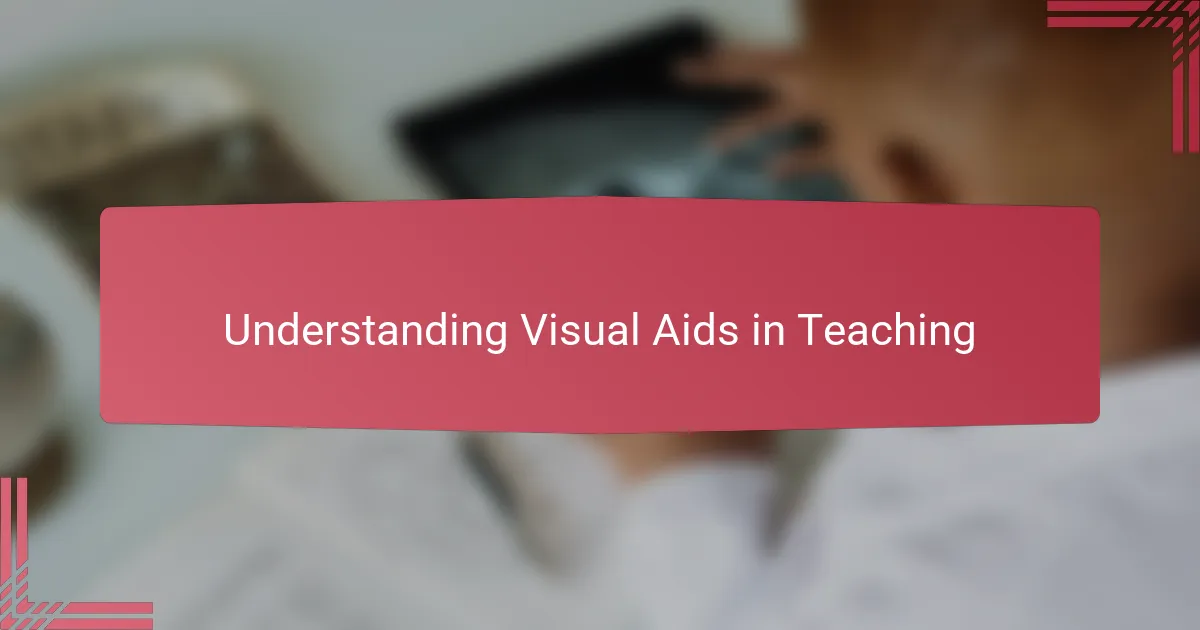
Understanding Visual Aids in Teaching
When I first started using visual aids in my lectures, I quickly realized that they are more than just decorative tools—they are gateways to deeper understanding. Visual aids capture attention in ways words alone often can’t, especially when the topic feels abstract or distant. Have you ever noticed how a simple diagram or image can suddenly make a complex idea click? That moment is pure teaching magic.
Visual aids help bridge gaps between different learning styles, something I’ve seen firsthand in my classroom. Some students grasp concepts better visually, while others need to hear explanations or engage through discussion. Incorporating visuals creates a more inclusive learning experience, allowing everyone to connect with the material at their own pace. It’s rewarding to witness shy or struggling students light up when a visual aids shifts their confusion into clarity.
On an emotional level, I find that visual aids also bring energy and variety to lectures that might otherwise feel routine or monotonous. They keep both me and the students engaged, breaking the cycle of passive note-taking. Have you ever felt your own enthusiasm wane during a lecture? Using images, charts, or videos injected a much-needed spark that reminded me why teaching is such a dynamic, creative craft.
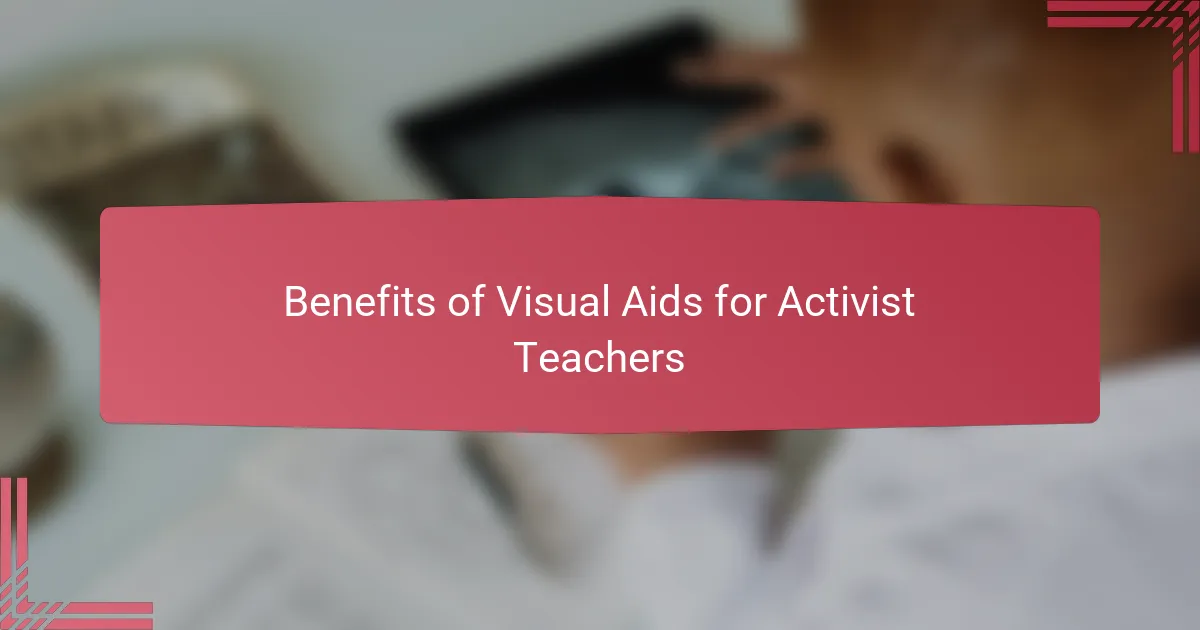
Benefits of Visual Aids for Activist Teachers
Visual aids have transformed how I connect with my students on important social issues. When I display compelling photos or bold infographics, it’s like a switch flips—those visuals make abstract concepts tangible and urgent. Have you ever seen a student’s eyes widen because a powerful image suddenly made them feel the weight of injustice? That moment fuels my commitment to teaching activism.
Another benefit I’ve noticed is how visuals empower students to think critically and question dominant narratives. Instead of passively receiving information, they analyze the layers behind an image or graph, sparking rich discussions. When a well-chosen visual challenges their assumptions, the classroom becomes a vibrant space of inquiry and awareness, which is exactly what I aim for as an activist educator.
Lastly, using visual aids helps me maintain my own passion and clarity in presenting complex, sometimes heavy topics. Activism can be emotionally draining, but visuals provide refreshing entry points that break down barriers. They remind me—and my students—that education is not just about facts, but about inspiring action through understanding and empathy. Isn’t that the heart of what teaching for social change is all about?
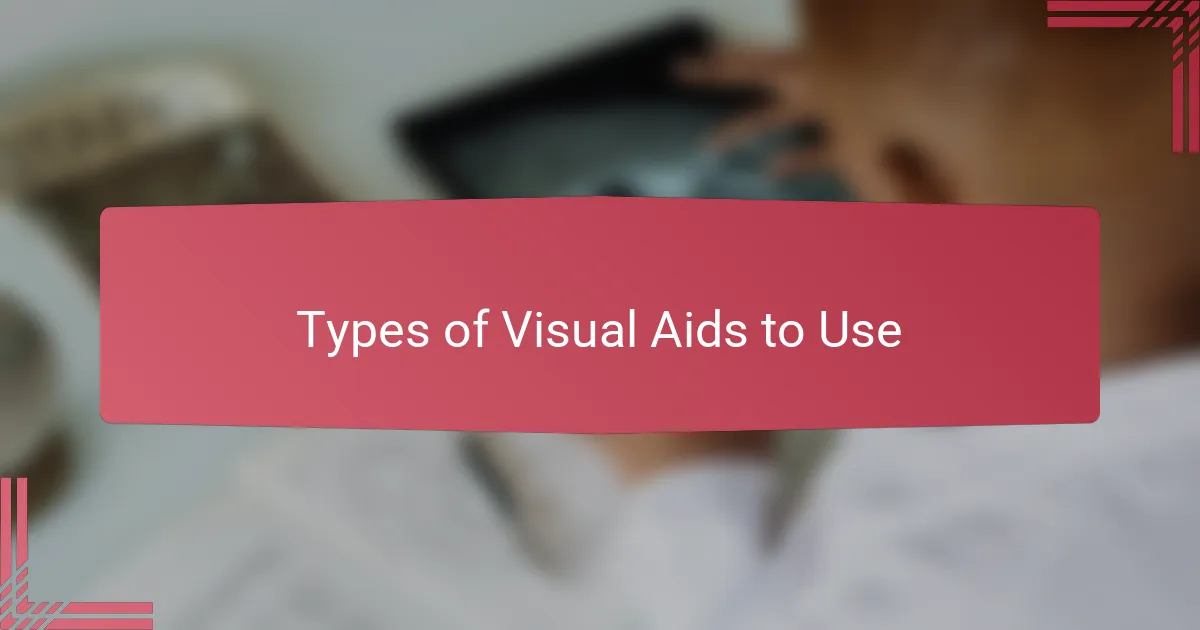
Types of Visual Aids to Use
When it comes to choosing visual aids, I’ve found that a mix of images, charts, and videos works wonders. Images grab attention immediately—like a powerful photograph can evoke feelings and set a tone before I even say a word. Charts, on the other hand, help break down data into digestible pieces, which is crucial when tackling heavy topics. Have you ever seen a student’s expression change when a confusing statistic suddenly makes sense through a simple graph? That’s exactly why I lean on charts during lectures.
Videos hold a special place for me too. There’s something about motion and sound combined that pulls students in, making abstract issues feel real and urgent. I remember once sharing a short documentary clip that sparked a lively debate—those few minutes energized the whole room. It reminded me how using different types of aids keeps the lesson fresh and the energy alive.
Even simple things like posters or infographics can be surprisingly effective. I’ve used bold, colorful infographics to summarize key points, and students often refer back to them during discussions. It’s like giving them a visual roadmap that guides their thinking. What types of visual aids do you think would resonate most with your students? From my experience, varying your approach based on the material and audience makes all the difference.
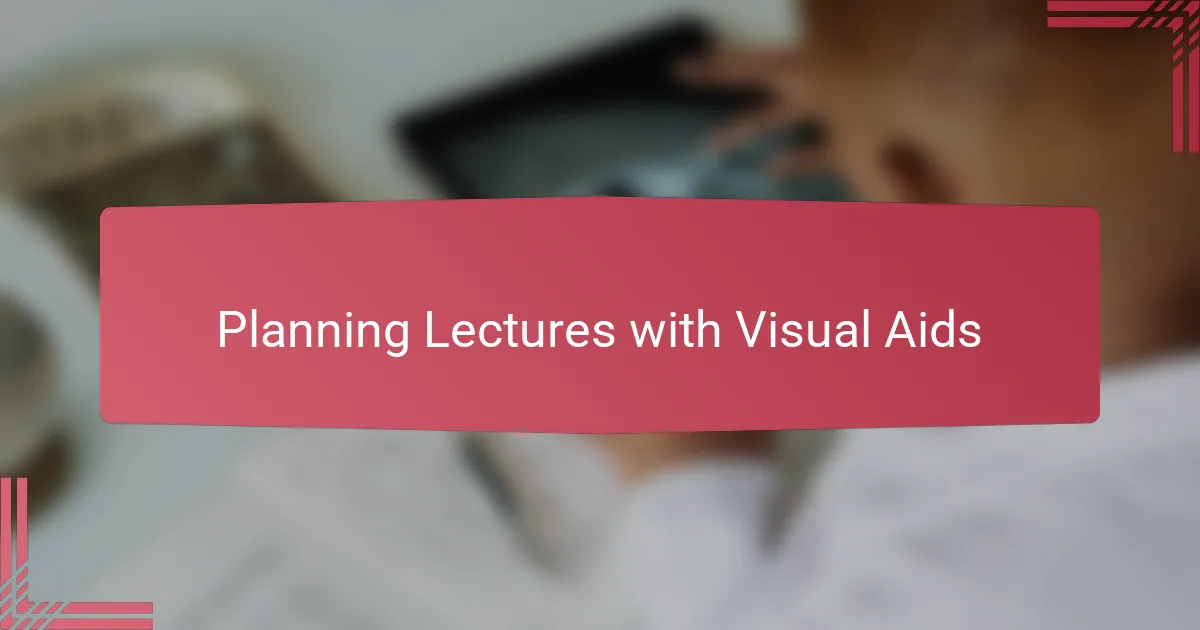
Planning Lectures with Visual Aids
Planning lectures with visual aids has always required careful thought for me. I ask myself which parts of the material will truly benefit from a visual boost—where a photo or chart can ignite curiosity or clear up confusion. It’s not about decorating slides; it’s about crafting moments where sight and sound work together to deepen understanding.
I also think about pacing. Early on, I learned that dropping too many visuals at once can overwhelm students instead of helping them. So, I space them out strategically, allowing time for reflection and discussion after each one. Have you ever noticed how a well-timed image can stop the room and invite everyone to think more deeply? That pause is something I plan for intentionally.
Lastly, tailoring visuals to the audience’s needs has become second nature. I remember preparing a lecture for a group new to activism and chose simple infographics to build foundational knowledge. Later, with more advanced groups, I could use layered images that challenge their perspectives. Planning with this flexibility in mind has made my lectures not just informative, but truly engaging and empowering.

Personal Experience Using Visual Aids
When I first introduced visual aids into my lectures, I was surprised at how quickly the atmosphere shifted. One moment, students seemed distant and disengaged, but as soon as I projected a striking image or clear chart, their attention sharpened almost instantly. Have you ever experienced that sudden spark in the room when everyone leans in, curious? That connection is what convinced me of the real power visuals hold.
I remember a particular lecture on environmental justice where I used a before-and-after photo series showing community impact. The emotional response from students was palpable—they weren’t just absorbing facts; they were feeling the issue deeply. It reminded me why I rely on visuals—not just to inform, but to foster empathy and ignite passion. Isn’t teaching about making ideas truly come alive?
Of course, not every visual lands perfectly every time. Early on, I learned that too many images can overwhelm rather than enhance understanding. I’ve since become more mindful, selecting a few meaningful visuals and giving students space to absorb and discuss. This careful pacing transformed how my classes engage with the material, making learning more thoughtful and less rushed. Have you found pacing to be just as important as the visuals themselves?
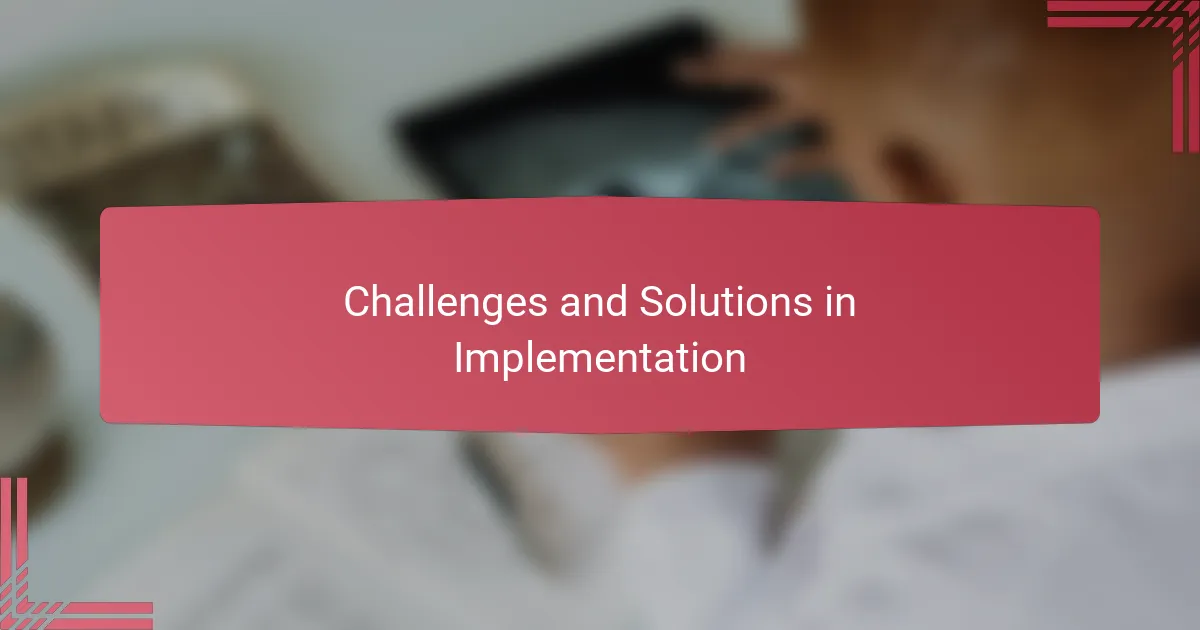
Challenges and Solutions in Implementation
One of the biggest challenges I faced was technical glitches—sometimes the projector wouldn’t cooperate, or videos wouldn’t play smoothly. Have you ever been mid-lecture when suddenly the screen goes blank? That moment of silence can throw off the entire flow. To tackle this, I always prepare backup plans, like printed handouts or offline copies, so the lesson keeps moving even if technology fails.
Another hurdle was balancing the amount of visual content. At first, I loaded slides with too many images, thinking more visuals meant better engagement. But I quickly saw students feeling overwhelmed, their attention scattered. So, I learned to be selective—choosing just a few strong visuals and pairing them with thoughtful questions. This approach helped create room for reflection rather than just passive viewing.
I also grappled with tailoring visuals to diverse student backgrounds. What resonates with one group might miss the mark with another. Remembering this, I started gathering feedback and experimenting with different formats—sometimes bold infographics, other times simple photos or charts. Hasn’t it been reassuring when students express that a particular visual finally made a complex idea click? That feedback loop became my guide for effective implementation.
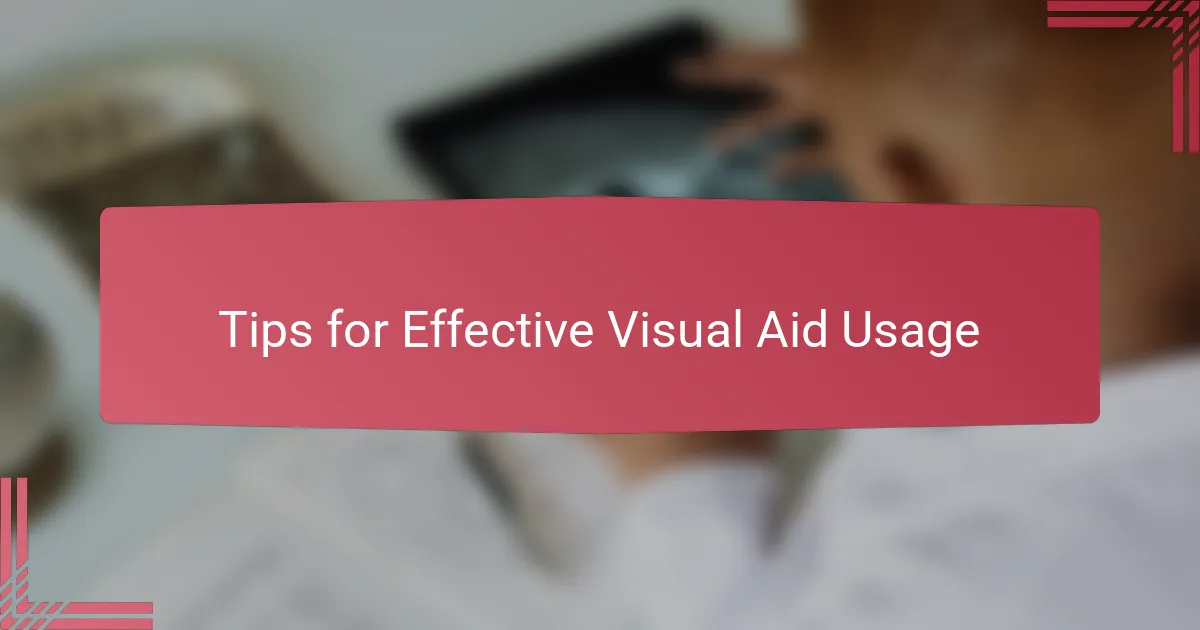
Tips for Effective Visual Aid Usage
One key tip I’ve found invaluable is to keep visuals simple and purposeful. Early in my teaching, I overloaded slides with text and images, thinking more meant better. But I quickly realized that clutter just distracted students instead of helping them. Now, I carefully choose each visual to highlight one idea at a time, which keeps everyone focused and makes the message clearer. Have you ever felt lost in a sea of too much information? That’s exactly what I avoid by streamlining visuals.
Timing is another game-changer. I learned not to rush from one image to the next, but to pause and let the visual breathe. When I allow moments for students to absorb and discuss what they see, the learning deepens. In several classes, I noticed how a well-placed photo or chart can spark thoughtful questions or personal reflections—something you don’t get with nonstop slides. Isn’t it amazing how pacing can turn a simple visual into a powerful conversation starter?
Lastly, I always tailor visuals to my audience’s needs. What worked for one group might fall flat with another, especially when dealing with complex social issues. I remember preparing a lecture on racial justice for a diverse classroom and opting for bold infographics to clarify key data. The students responded with enthusiasm and engaged in meaningful debate. This reinforced my belief that knowing your audience and adapting visual aids accordingly is essential for effective teaching. What’s your experience with adjusting visuals to fit different groups?